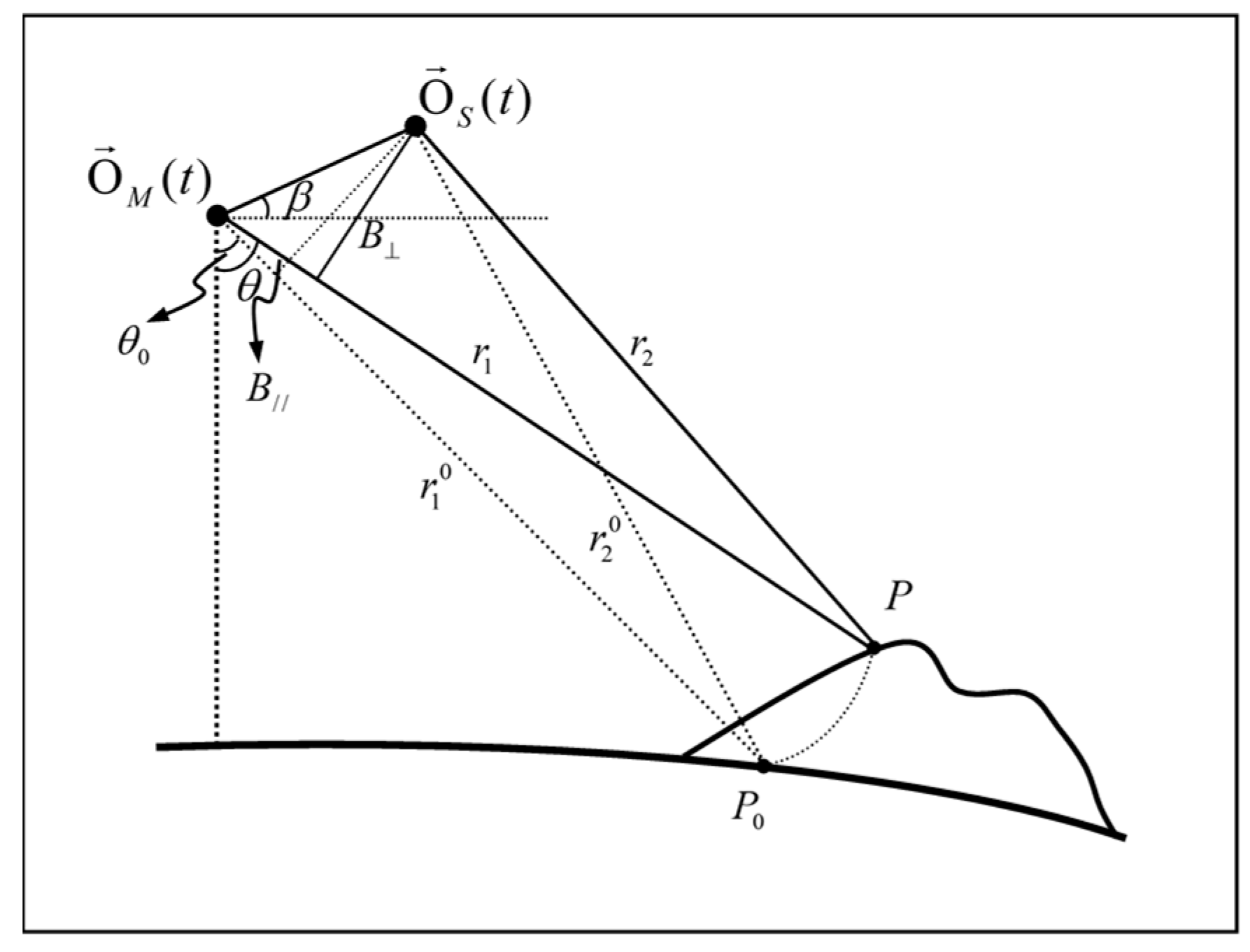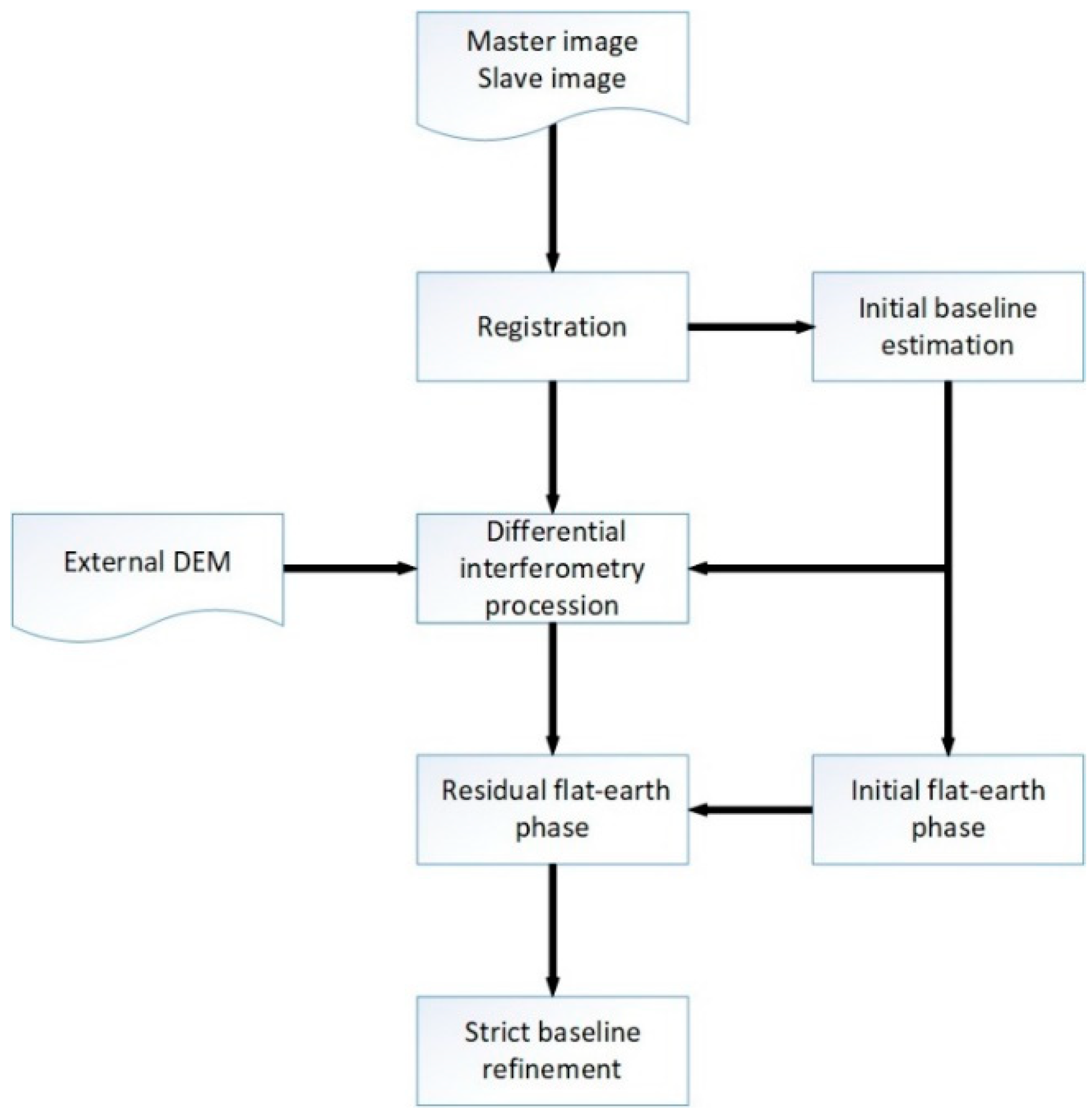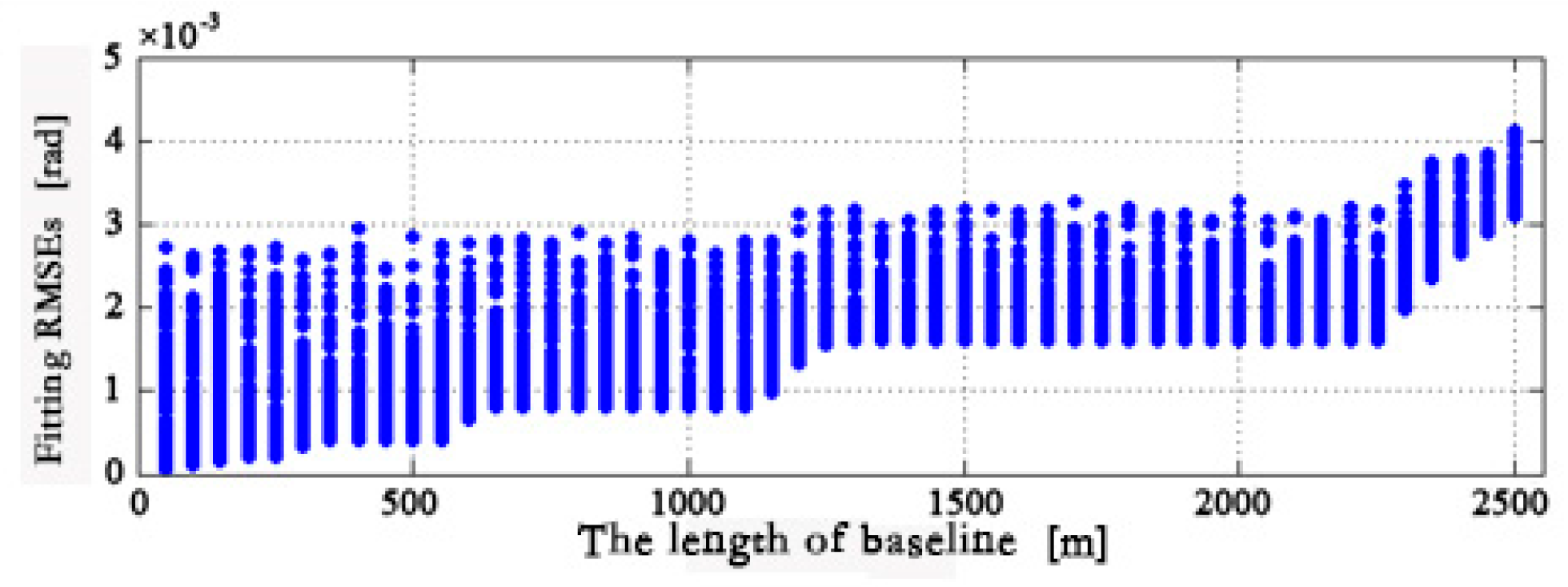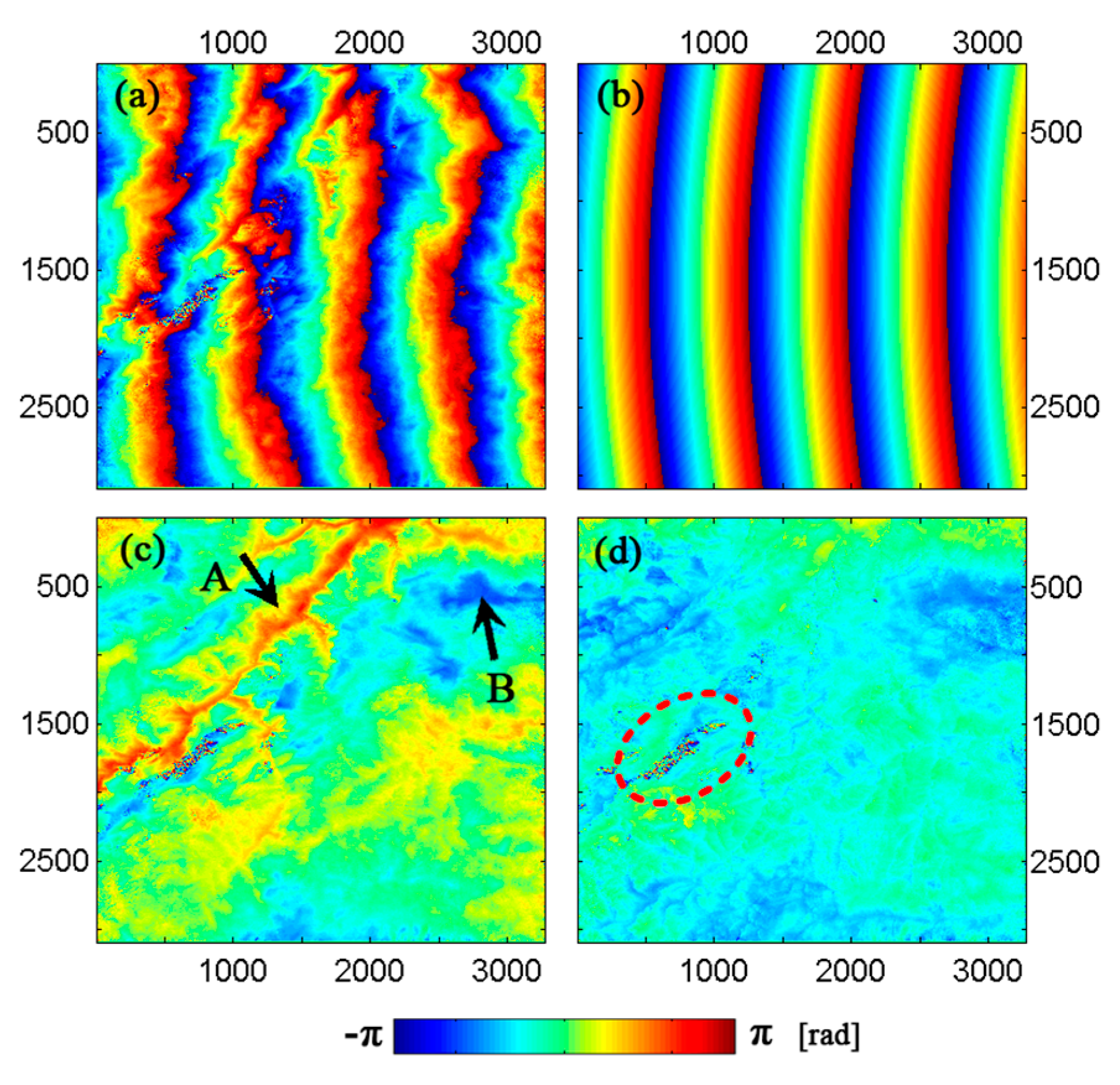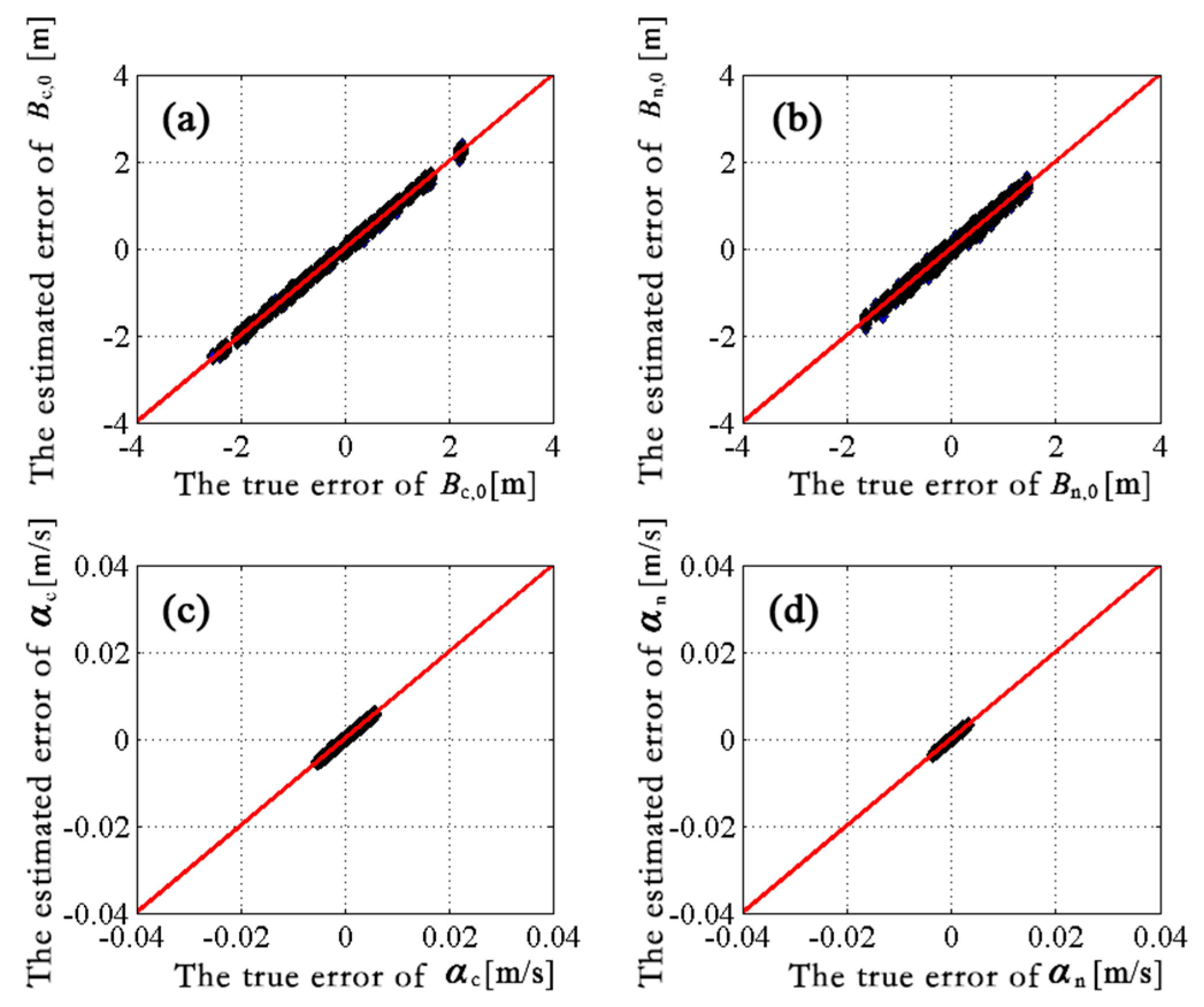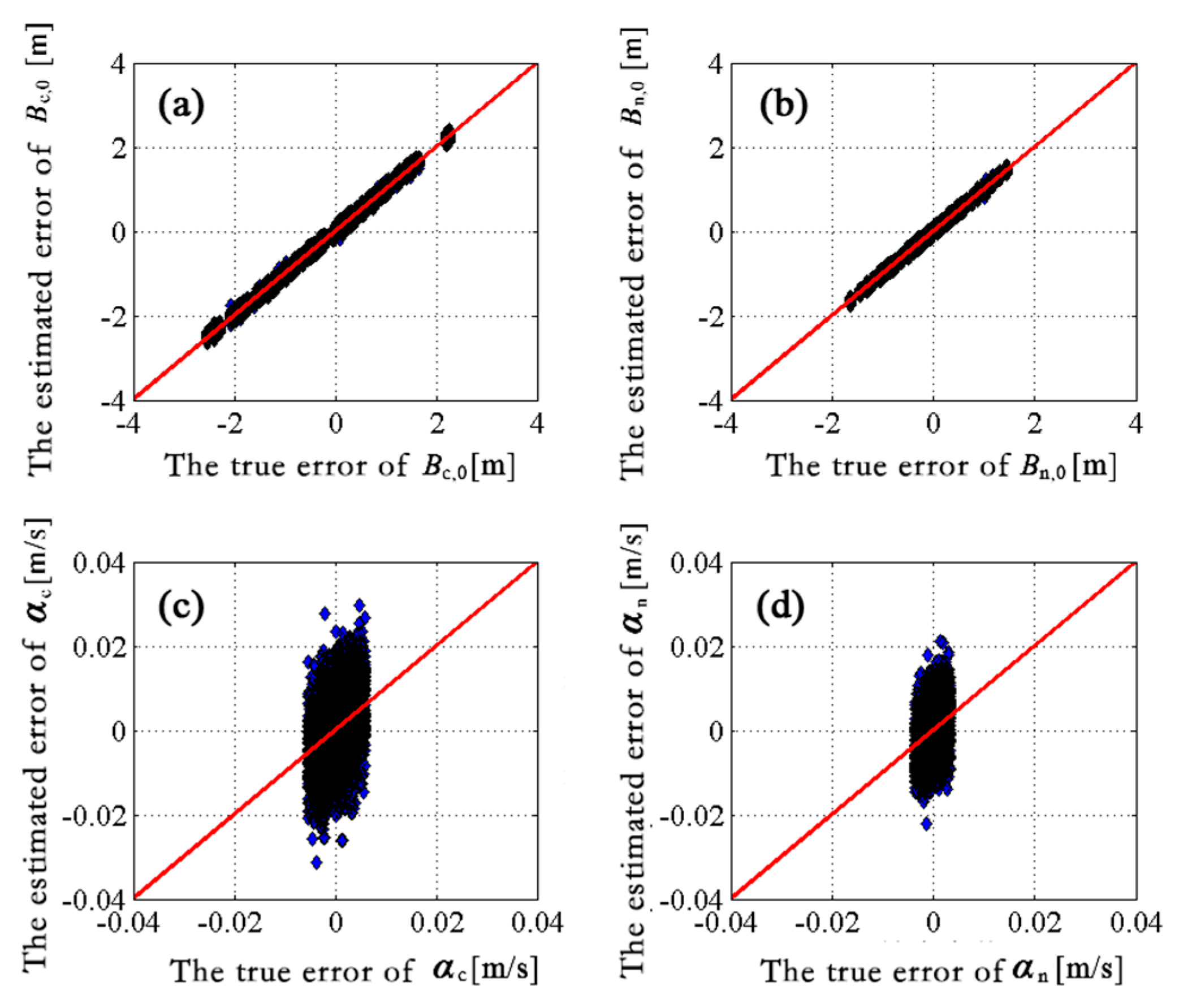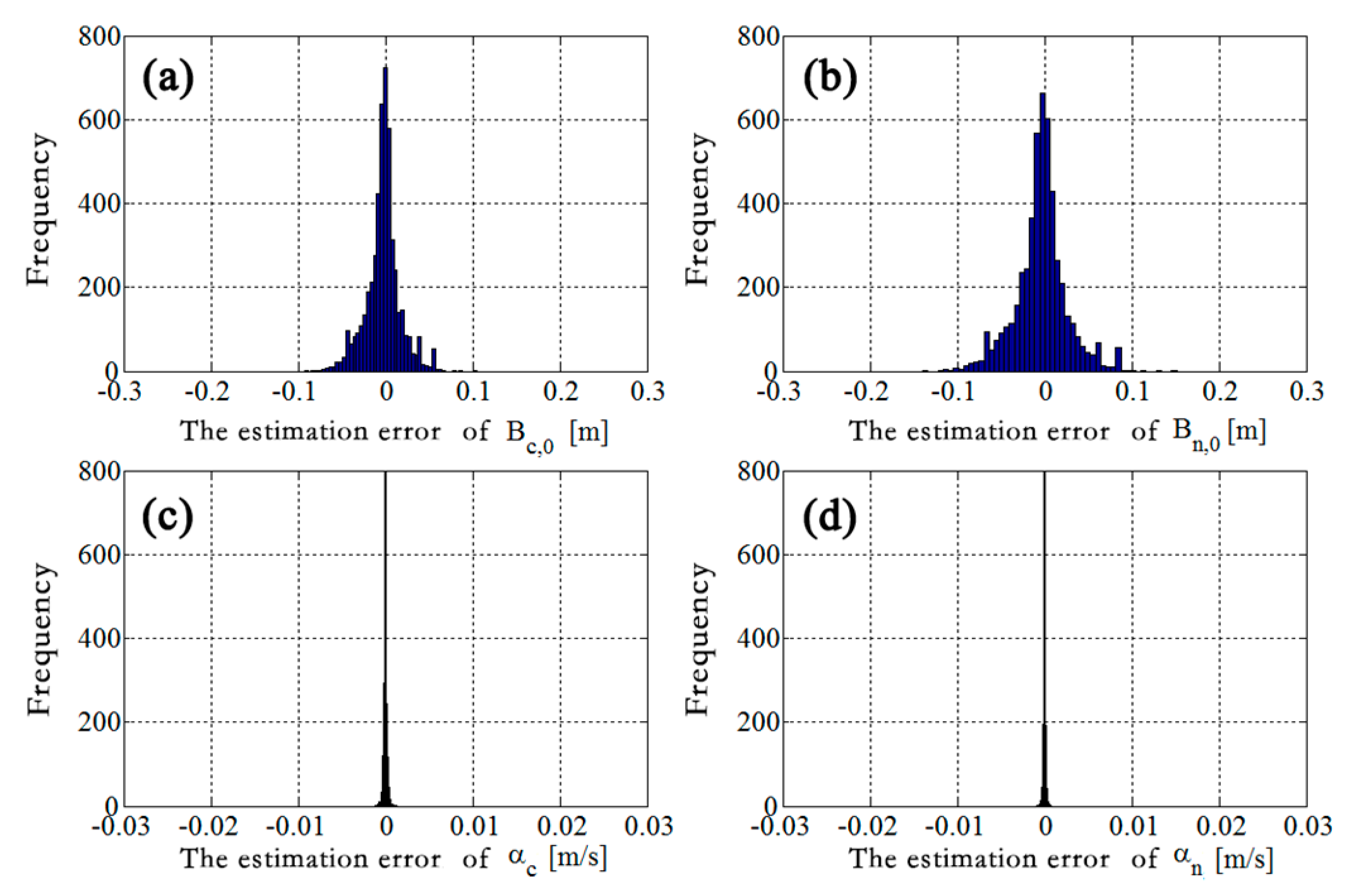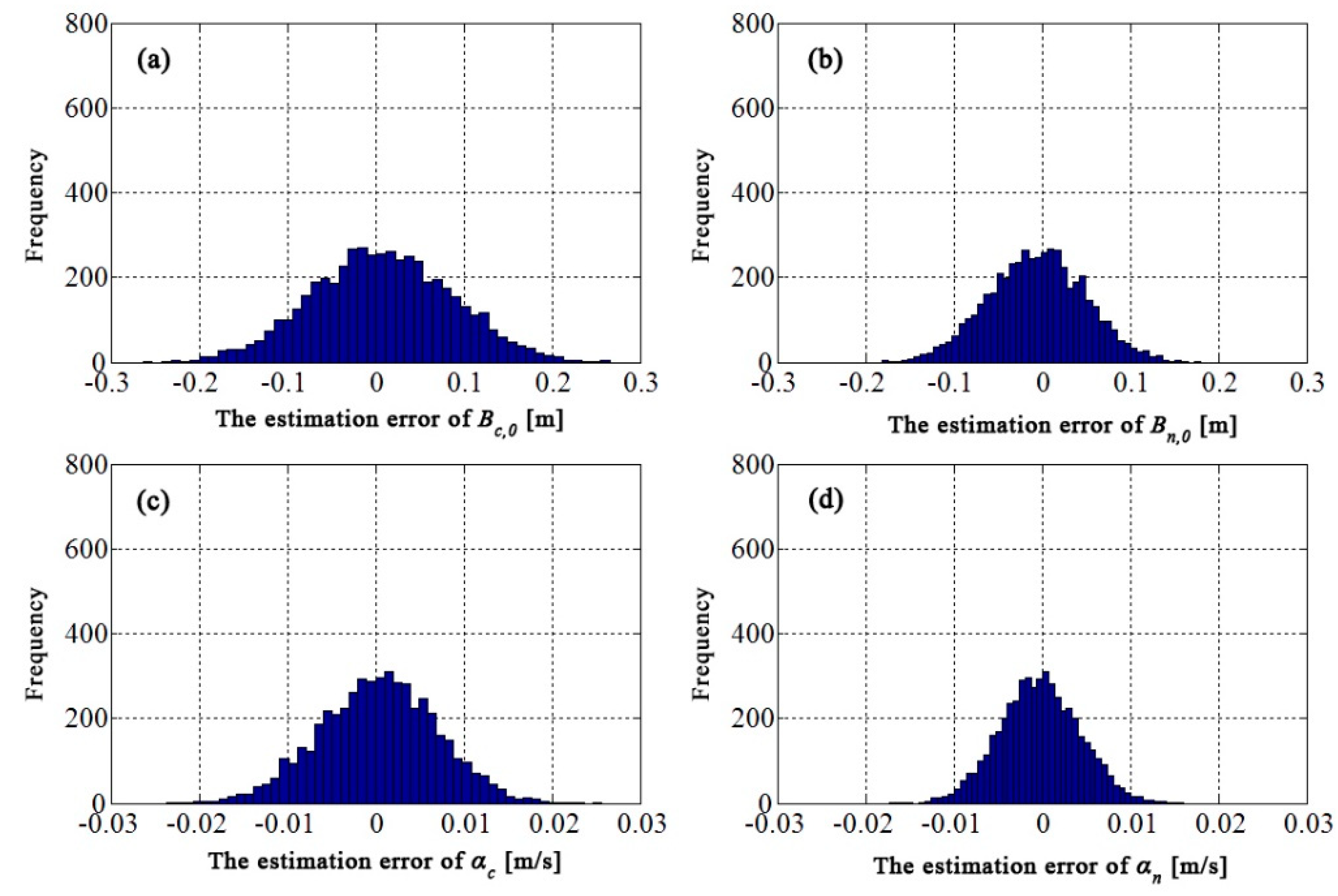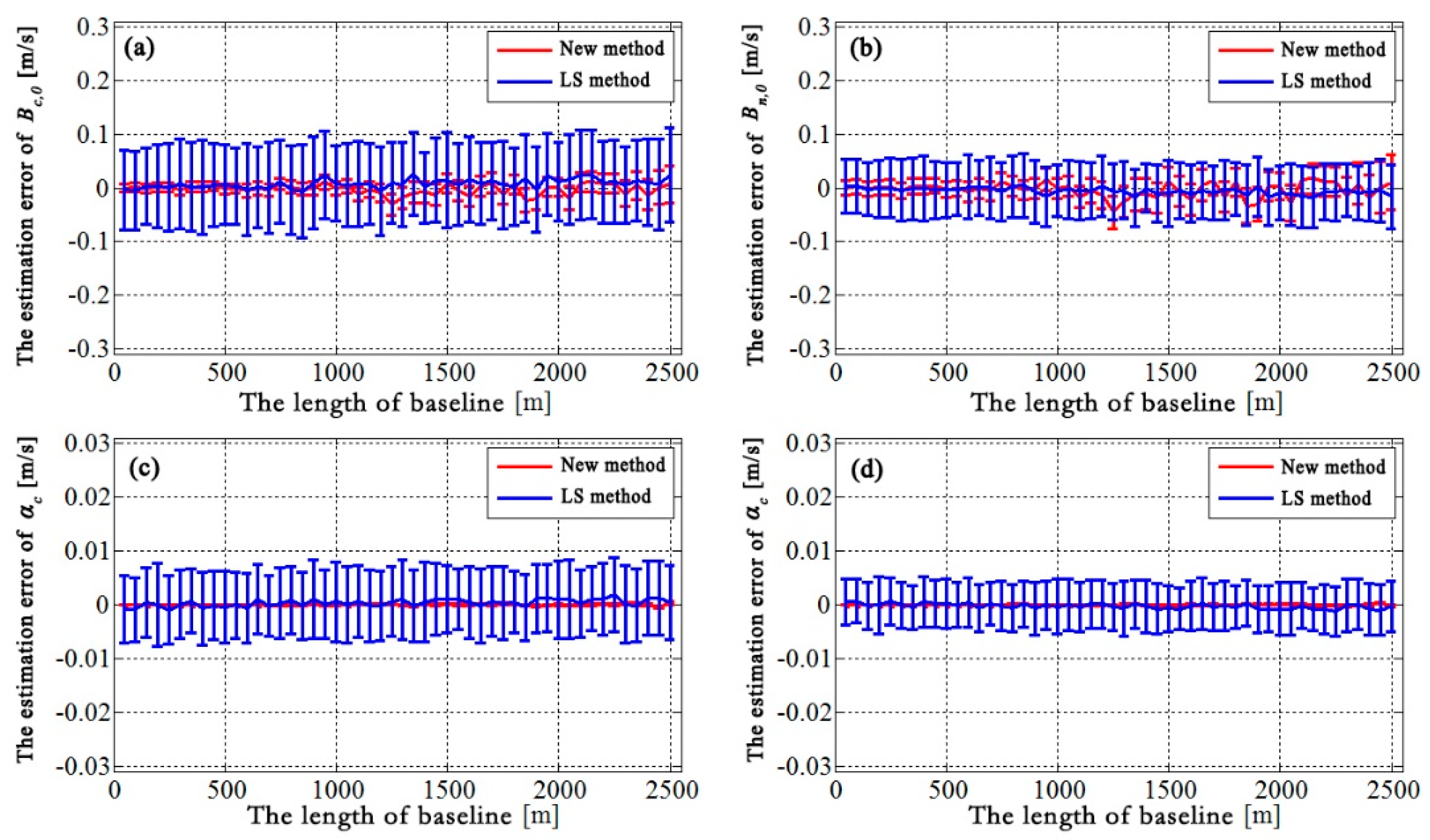1. Introduction
During the past two decades, the interferometric synthetic aperture radar (InSAR) has been gradually matured in terms of theory and widely used in topographic mapping [
1] and surface deformation monitoring [
2]. For example, the shuttle radar topography mission (SRTM) data forms a popular digital elevation model (DEM, a surface model representing ground elevation as an ordered set of numerical arrays), which is acquired by airborne SAR [
3]. Recently, the application fields of InSAR have been expanded from earthquakes, volcanic eruptions, ground subsidence, and other large-scale macroscopic monitoring to infrastructure monitoring, such as bridges, dams, and buildings, as well as high-accuracy 3-D urban reconstruction [
4,
5,
6], the prospect of which is very broad.
However, the accuracy of InSAR is affected by a variety of errors, such as atmospheric delay error, DEM error, random phase error, and baseline estimation error. Among such errors, interferometric baseline estimation error systematically and seriously affects the accuracy of InSAR measurement [
7]. The error of the interferometric baseline affects not only the removal of the flat-earth phase, but also the transformation coefficient between the topographic phase and elevation, which will affect the topographic phase removal for D-InSAR and the accuracy of the finally generated DEM product for InSAR. The present methods of initial baseline estimation make it difficult to obtain high-accuracy baseline estimations due to factors such as the precision of the satellite orbit state vector.
The baseline estimation method based on the satellite orbit state vector utilizes the difference in instantaneous satellite coordinates to obtain the interferometric baseline estimation, while it is directly affected by the precision of the satellite orbit state vector. According to the law of error propagation [
8], the accuracy of the results is lower than that of the satellite orbit state vector. Several SAR satellites are equipped with global navigation satellite system (GNSS) positioning devices, such as TerraSAR and COSMO-SkyMed, the precise orbit state vector accuracy of which is about 5 cm and the fast track accuracy of which is only 10 cm [
9]. The orbit state vector accuracy of ERS-1/2 and ENVISAT (Environmental Satellite) is as low as 10~15 cm [
10,
11], while that of ALOS (Advanced Land Observing Satellite)/PALSAR (Phased Array type L-band Synthetic Aperture Radar) is even worse [
12].
The baseline estimation method based on image registration offset [
13,
14,
15] converts the range offset estimation into slant-range difference, using the relationship between the slant-range offsets and distance between the master image and slave image, and calculates the interferometric baseline estimation with SAR imaging geometry. Restricted by the accuracy of the image registration algorithm, the accuracy of baseline estimation is relatively low, and is generally at a meter or decimeter level [
15]. For example, if the accuracy of SAR image registration reaches 1/10 pixel, then that of the slant-range difference is about 30 cm for TerraSAR with a 3 m resolution. Therefore, the accuracy of interferometric baseline estimation is low.
The baseline estimation method based on the visible fringe rate is derived from the paper on the beam transform published by the Italian researcher Gatelli in 1994 [
16]. Gatelli et al. proved that the interferometric baseline can be determined by the relationship between the fringe frequency and SAR spatial geometry. Hence, once the fringe frequency can be accurately obtained, the SAR interferometric baseline estimation can be calculated. Many researchers have carried out a lot of research on this method, such as Wegmuller [
13], Li Xinwu [
17], Tang Xiaoqing [
18], Fan Hongdong [
19], Xu Huaping [
20], and so on. In practice, due to the lack of accurate terrain slope information, we usually select flat terrain to estimate the fringe frequency and interferometric baseline. However, some defects still exist in this method: on the one hand, it is difficult to search flat terrain in some cases, and on the other hand, the calculation accuracy is affected by the window size that is adopted by fast Fourier transform (FFT) for obtaining the fringe frequency, as well as the interferometric phase within the window. The SAR interferometric baseline in the whole interferogram is not a fixed value, which means that it changes over time. This means that the method has to calculate the fringe frequency based on the interferogram within a certain window (e.g., 512 × 512 pixels) to get the average baseline of the selected area. The larger the window one adopts, the more accurate the estimation is, while the deviation from the local real baseline is larger, caused by more interferogram samples being contained. Conversely, when the estimation window is small, the deviation between the baseline estimation and local real value can be smaller, but its accuracy is affected by the interferogram.
According to an analysis of the existing methods for SAR interferometric baseline estimation, we can see that all of these methods have inherent defects, meaning that they cannot obtain highly accurate baseline estimations. To remove the phase error caused by inaccurate baseline estimation, there are two methods available, namely, interferometric phase error correction [
21] (e.g., planar polynomial fitting) and precise baseline estimation [
22]. It has been proven that planar polynomial fitting can just subtract the trend of the baseline error from the interferogram, while the topographic phase residuals caused by phase error still remain [
23]. This part of the error is associated with the elevation and can easily be considered as the atmospheric error related to elevation. Therefore, an interferometric baseline refinement procedure is necessary for real InSAR data processing. Small et al. [
22], Joughin et al. [
24], and Kimura et al. [
25] have successively proposed a baseline refinement method based on the ground control point (GCP). The method establishes the observation equation on the basis of the known unwrapped phase and GCP elevations and computes the baseline parameters using the least-squares algorithm, so the method is called the baseline refinement with least-squares (LS) (hereinafter referred to as the LS method). However, in many cases, we cannot obtain the ground control points of the interest area. By taking advantage of the geometric relationship as the slant-range ellipsoid, Doppler cone, and earth ellipsoid intersect at the GCP, Liu et al. [
26] calculated the elevation of GCP with iterations and then computed the baseline estimation based on LS. However, the accuracy of the iterative calculation of GCP is limited.
In recent years, some researchers have combined SAR interferometric baseline refinement with multi-temporal InSAR and proposed corresponding methods [
27,
28]. However, when calculating radar vectors in line of sight (LOS), the baseline refinement models they have used are highly dependent on the precision of ground elevation information, which affects the accuracy of the baseline refinement results to some extent.
In order to obtain an interferometric baseline with a high accuracy and avoid the dependence of the refinement model on ground elevation, this paper firstly investigates the geometry of InSAR imaging and analyzes the rigorous geometric relationship between the interferometric baseline and flat-earth phase in detail. Then, a baseline refinement method without GCPs is proposed and the geometry is converted from precise baseline estimation to an InSAR flat-earth phase. We develop the theoretical model and resolving method. Synthetic and real SAR datasets are used in the experiments. Compared with the conventional LS method, the proposed method is more effective and advantageous.
2. SAR Interferometric Baseline Model
Since the orbits of an SAR satellite do not coincide with each other at the time of imaging, we refer to the spatial vector consisting of the satellite platform orbital positions as the SAR interferometric baseline, i.e.,
where
is the 3-D spatial coordinate vector of the SAR sensor platform at ground point P;
and
are the acquisition times of point P in the master and slave image, respectively; and
,
, and
are the baseline components in X, Y, and Z directions, respectively.
As shown in
Figure 1, the baseline can be represented as the parallel component along the LOS of the radar and the perpendicular component perpendicular to the LOS, i.e.,
It should be noted that the precise look angle is required for this baseline decomposition, while its calculation depends on the ground elevation. Here, we introduce an alternative baseline representation independent of ground elevation for subsequent theoretical derivation.
We adopt an SAR platform-fixed coordinate system, TCN (see bibliography [
22,
26] for details, T, Along-Track, the flight direction of satellite; C, Cross-Track, perpendicular to the plane consisting of T and N to meet the left-handed coordinate system; N, Normal-Direction, the direction from the center of the earth towards the satellite). Then, the transformation matrix from the earth-fixed coordinate to the TCN coordinate is formed by
where
,
, and
, represent the unit vectors of the T axis, C axis, and N axis in the earth-fixed coordinate, respectively [
26]. The baseline can be converted to the TCN coordinate by
As we can see from Formula (5), the decomposition of the baseline in the TCN coordinate does not depend on the ground elevation, which will be adopted for the subsequent theoretical derivation.
Since the SAR interferometric baseline in the whole interferogram is not a fixed value, we can model the baseline components using linear formulas, i.e.,
where
and
respectively represent the components in the directions C and N of the SAR interferometric baseline model at the reference time, namely the baseline constants. We usually set the image centers as the time reference points (then
and
are the components of the image center baseline in the directions C and N, respectively).
and
are the baseline change rates in the directions C and N, respectively.
is the time at which the point was acquired relative to the reference time.
,
,
, and
are unknown model parameters. Here, taking the image co-registration into account, the baseline component in T has been eliminated, which means
and is no longer within consideration.
3. Improvement of the Goldstein Filter By the Coefficient of Variation
3.1. Coefficient of Variation
According to SAR imaging geometry (see
Figure 1), the unwrapped flat-earth phase can be expressed by
where
is the radar wavelength,
is the decomposition of the slant range in TCN coordinates, and
is the unwrapped flat-earth phase of the reference point. Based on Cosine law, we can get
and
Given
N observations, let the observation vector
with the size of
.
is the parameter vector to be resolved. Additionally,
is the non-linear equation of parameter vector
X. Then, Equation (8) is rewritten into the observation equation as
where
is the error vector of observation
. Equation (11) is a non-linear equation, and in this paper, it will be transformed into a linear one. By expanding Equation (11) into Taylor Series at
, retaining zero- and first-order items, and writing it as an error equation, we can get
where
and
.
Let
of which
where
(or
) and
(or
) are the nominal slant ranges of master and slave acquisition, respectively (i.e., with respect to the ellipsoid reference surface, see
Figure 1).
Then, Equation (12) can be rewritten as a matrix form:
The corresponding normal equation is
where
is the weighted matrix of the observation vector
L.
Assuming that the observation values are mutually independent, let the prior variance matrix be
where
represents the variance of observation value
. Then, we can utilize the residual unwrapped differential interferometric phase
without system signals to estimate
.
From Equation (14), we can see that five or more observations, i.e.,
, are needed to estimate the five unknowns. The best linear unbiased estimation of
is
where
P is the weighted matrix. Therefore, the best linear unbiased estimation of
X is
By analyzing design matrix
A, if the initial parameter vector
is close to the true vector
X, the numerator of each element in the first four columns of
A will become very small. After being divided by
, the first four columns will become highly linearly dependent on each other, i.e., the design matrix
A will tend to be multicollinear. Therefore, the normal equation, Equation (14), will become an ill-condition. The least-square estimates obtained with Equation (16) are not reliable in this situation. Therefore, we can introduce ridge estimation [
29] to solve this problem and Equation (14) can be rewritten as
where
k is a positive constant value named the ridge parameter and
I is the identity matrix. It should be noted that ridge estimation is used to improve the ill pose condition of Equation (14), but the small value
k still leaves
singular. In this context, truncated singular value decomposition [
30] (TSVD) is used to compute the pseudo-inverse of
. Let SVD of
be
where
and
are 5 × 5 unitary matrixes, and the diagonal matrix
contains non-negative singular values
. The threshold of TSVD is defined with
where
is used for calculating the largest singular value. The pseudo-inverse of
with the condition of
is
Then, the pseudo-inverse of
is
Therefore, the ultimate estimation of
X is
By substituting Equation (23) into Equation (17), the estimation of X can be resolved.
3.2. Model Resolving
According to the previous analysis, we can easily solve the model problem above and get the estimation X with the determination of the weight matrix P and ridge parameter k, which are not given precisely at first. Simultaneously, some other problems still exist in Equation (11). Therefore, iterative parameter estimation is adopted to solve these problems. The detailed steps are as follows:
Step 1: Model initialization. Let the initial weighted matrix be an identity matrix, ridge parameter , which will not cause large deviations, and , where the first four values are initial baseline parameters calculated from the orbital state vector. Furthermore, let the initial reference point phase be ;
Step 2: Expand Equation (11) into Taylor Series at
to compute the design matrix
A and vector
l to establish the normal equation Equation (14). To evaluate the quality of the model, obtain the sum of weighted squared residuals (SWST) by
where
and
. Let
;
Step 3: Add k to the diagonal of coefficient matrix in normal equation Equation (14), establish the ridge normal equation Equation (18), and calculate the corresponding pseudo-inverse ;
Step 4: Calculate based on Equation (23). Expand Equation (11) into Taylor Series at , calculate the new design matrix and vector , and establish the new by Equation (24);
Step 5: Compare with , determine whether to accept the parameter vector , and output the sum of weighted squared residuals .
If
, then calculate
with Equation (17), and update
, as well as the design matrix
and vector
, reducing ridge parameter
. Update the weighted matrix
with
, where
is a positive number, such as 10
−3, preventing the new weights from being too large, and then let
. Conversely, keep
,
,
A,
and
P unchanged, and update
. Actually, the
SWST changes slowly with the magnitude of
k. Therefore, scaling the magnitude of
k up or down at the ratio of ten will accelerate convergence [
31,
32,
33];
Step 6: Determine the terminative condition of the iteration: if it has just iterated once and
, jump straight to Step 3 to for a second iteration; if it has iterated more than once, then the terminative condition is
which meets twice or the maximum iteration number is greater than 20. If the condition has been met, then output the result parameter vector
. Alternatively, return to Step 3 and go on with the iterations. As the number of iterations increases, the ridge parameter
k gradually becomes unbiased.
3.3. Algorithm Flowchart of Baseline Refinement
As we can see from
Section 3.1, SAR interferometric baseline refinement can be strictly performed as long as the flat-earth phase
is accurately obtained. There are two steps for obtaining an accurate flat-earth phase. First, calculate the initial baseline using the orbital state vector, as well as the corresponding flat-earth phase
. Due to the inaccurate baseline,
is not equal to
. Furthermore, process differential interferometry using the initial baseline combined with external DEM and unwrap the interferogram. Then, calculate the flat-earth phase residue with planar polynomial fitting, which will be verified in the experiment part. Add
and
to make
. Therefore, a detailed flow of the proposed algorithm for baseline refinement is as follows:
Register master and slave images, and estimate the initial baseline using the orbital state vector to get , , , and ;
Process differential interferometry of SAR data using initial baseline results, and calculate flat-earth phase from the unwrapped interferogram using planar polynomial fitting;
Calculate flat-earth phase using initial baseline estimation and add and obtained from step 2 to make a “true” unwrapped flat-earth phase ;
Refine the interferometric baseline strictly and obtain an accurate estimation of the SAR interferometric baseline. Firstly, establish adjustment models of baseline parameters, including a functional model with
obtained from step 3 based on the method introduced in
Section 3.1 and the random model. Then, calculate the model parameters according to the algorithm in
Section 3.2. By expanding Equation (11) into Taylor Series to build the normal equation, simultaneously calculate the sum of weighted squared residual
. The iteration mainly exists in ridge estimation and truncated singular value decomposition (TSVD). The magnitude relationship between
and
resulting from the iteration above is regarded as the terminative condition of iteration. If the condition is met, end the iteration and output the accurate SAR interferometric baseline estimation.
The specific flowchart is shown in
Figure 2.
6. Conclusions
Interferometric baseline estimation is a key procedure of InSAR data processing. The error of the interferometric baseline affects not only the removal of the flat-earth phase, but also the transformation coefficient between the topographic phase and elevation, which will affect the topographic phase removal for D-InSAR and the accuracy of the finally generated DEM product for InSAR. To obtain a highly accurate interferometric baseline, this paper firstly investigated the geometry of InSAR imaging, and established a rigorous relationship between the interferometric baseline and the flat-earth phase. Then, a baseline refinement method without a ground control point (GCP) was proposed, where a relevant theoretical model and resolving method were developed. Synthetic and real SAR datasets were used in the experiments, and comparisons with the conventional least-square (LS) baseline refinement method were made. The results demonstrate that the proposed method exhibits an obvious improvement over the conventional LS method, with percentages of up to 51.5% in the cross-track direction. Therefore, the proposed method is effective and advantageous.
In general, the application of the conventional LS method is limited due to the lack of available GCPs in the study area. The baseline refinement based on the LS method processes the observation (unwrapped interferometric phase) with equal weight by using the unwrapped interferometric phase and the rigorous geometric relationships of baselines when calculating the equations. Due to the errors, such as atmospheric delay error, the equal weight process will result in deviations of the results, which is obvious in the interferogram, which displays an apparent fluctuation of atmospheric error.
The interferometric baseline refinement proposed in this paper takes advantage of the unwrapped flat-earth phase and rigorous relationship of baselines, which is independent of GCP. During modeling, since the observation is the flat-earth phase without atmospheric error, the effect of atmospheric error on baseline estimation has been avoided. However, it should be noted that the flat-earth phase residual is obtained by using global polynomial fitting for the interferogram, so that the flat-earth phase may absorb some other signals, such as the deformation signal with longer wavelengths distributing globally. For this insufficiency, we can parameterize the flat-earth phase residual by using time series InSAR, where the flat-earth residual is calculated at the same time as the deformation parameters. Relevant thoughts have been studied by researchers, and will be introduced into the baseline refinement method proposed in this paper in the future to make it more general.
